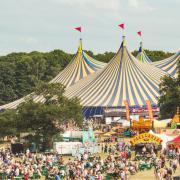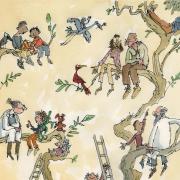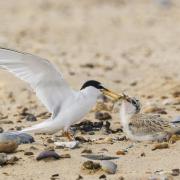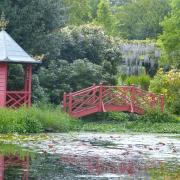Ipswich often gets a bad rap. Like any provincial town, it has its faults, but previous generations were mostly proud of the county town. And though it was occasionally the butt of a comedian's joke, it was always affectionate and good natured. It's time to restore a bit of pride, and the man to do it is Cardinal Thomas Wolsey.
Okay, he's been dead for several hundred years, but Wolsey, son of Ipswich and an over-achiever if ever there was one, is inspirational. Things might have been very different for Ipswich had he been able to realise his great ambition to make the town a glorious seat of learning that would rival the likes of Eton and Oxford.
From humble origins, growing up in the jumble of Ipswich's medieval streets, where his father was a butcher, young Thomas was, nevertheless, well educated, probably at Ipswich School. He took his schooling seriously, making it all the way to Oxford University to study theology. At 29 he was chaplain to the Archbishop of Canterbury; by the age of 36 he was Henry VIII's almoner, with a seat on the Privy Council. By 42 he was Lord Chancellor, the highest office in the land, second only to the sovereign.

During 14 years in office, Wolsey amassed more power than any other Crown servant in English history. He had the king's total confidence and, with special powers given by the Pope as legate, Wolsey dominated civic affairs, administration, the law, the church, and foreign policy. He was energetic and ambitious, clever, capable and hard-working. He built a great fortune for himself, and became a major benefactor of arts, humanities and education.
This tremendous role model was undone, however, by his inability to get a divorce for Henry VIII from his first wife, Catherine of Aragon, freeing him to marry Anne Boleyn. Henry was convinced – probably by Anne and her supporters – that Wolsey was slowing down proceedings. Wolsey was arrested, stripped of office and eventually accused of treason. He died at Leicester, on his way to London to plead his case. He was 57.
READ MORE: Suffolk greats: Thomas Wolsey, son of Ipswich
But about that plan. Before Wolsey was removed from power, he had begun, in 1528, an ambitious project for a 'college' school in Ipswich, incorporating Ipswich school. It was intended as a feeder to his recently built Cardinal's College of Oxford University (now Christ Church). When he fell out of royal favour, the half-built college was demolished. Sadly, all that remains is the waterside gate on College Street.

You can discover all this and more about Thomas Wolsey in a superb exhibition at The Hold in Ipswich, home to Suffolk Archives. Wolsey's Ipswich is on until October 29 and is free as part of the Wolsey 550 celebrations to celebrate the 550th anniversary of the great man's birth. The exhibition explores the life and legacy of Wolsey, using archive treasures from Suffolk's own collections as well as some spectacular loaned exhibits. (Spoiler alert: Wolsey's original cardinal hat on loan from Christ Church College, Oxford; and an original of Shakespeare's first folio, on loan from Trinity College, coinciding with Folio 400, marking 400 years since the first printed collection of the Shakespeare's work.)
Coinciding with the exhibition, but also permanently on offer, is a self-guided, two-hour walk called Cardinal Connections, which leads you in a discovery of Wolsey's Ipswich, taking in sites associated with him, or relating to the times in which he lived. It's a fascinating way to see the town, wandering through its medieval parishes, and leaves you with an appreciation of its rich, under-celebrated history.
The walk
1. Start at the first site, St Clements Church on the corner of Grimwade Street and Star Lane. The church dates from the 14th century and was known to many as the Sailors' church' as St Clement is the patron saint of sailors. Circumnavigator Thomas Eldred (1561-1624) and Thomas Slade, who designed Nelson's ship, Victory, are both buried here. Head west along Star Lane, crossing over when you reach Fore Street. Head up the street, turning left at the junction with Lower Orwell Street, then continuing along Blackfriars Walk.
2. The second site are the ruins of Blackfriars Priory, the only remains of five religious houses that once stood in Ipswich. The Dominicans lived here from 1263 until the priory was dissolved in 1538. The origins of Ipswich School are also thought to be in this part of town. In 1483, it moved to a house in Foundation Street (now a car park), which borders the priory. It moved briefly to Wolsey's new college before occupying the old dormitories of Blackfriars in 1614 where it stayed until 1842. Emerge into Foundation Street, turn right and head up to Tacket Street. Turn left, then right into Upper Orwell Street, then left into the Buttermarket.

3. Continue along the Buttermarket until you reach the Ancient House, also known as Sparrowe's House. The site dates from at least the 14th century; the oldest part of the house a century later. The current building was built by the Sparrowe family in the mid-17th century, when the decorative plaster work (pargetting) on the front was also added by Robert Sparrowe. Considered one of the finest examples in the country, it depicts four panels representing the continents of Africa, Asia, Europe and America (Australasia had yet to be discovered).

4. Opposite the Ancient House is Dial Lane. Head up here to St Lawrence Church, built in the 15th century. Its tower features beautiful flushwork – decorative masonry work which combines flint and ashlar stone on the same flat plane. The tower contains a complete ring of five medieval bells, one of only two in the country, the other being in St Bartholomews in Smithfield, London. St Lawrence's bells are known as 'Wolsey's bells'; he would have heard four of them being rung. It's thought his wealthy uncle, Edmund Daundy, added a fifth around 1480.

5. Next, head north to Tavern Street. Turn right and walk along to the main junction with the old Great White Horse Hotel on the corner. Turn left up Northgate Street, passing lovely old buildings housing a solicitors' office, until you reach Ipswich County Library on your right. Opposite is Pykenham's Gatehouse. This beautiful timber and brick gateway is all that remains of a grand residence built in 1471 for William Pykenham, Archdeacon of Suffolk, and is one of Ipswich's oldest buildings still in existence.

6. Walk north to the end of Northgate Street, cross over Crown Street/St Margaret's Street and head up Soane Street, where you'll find the entrance to Christchurch Park, home to beautiful Christchurch Mansion. This grand Tudor mansion is a treasure for Ipswich, built on the site of the Priory of the Holy Trinity. After Dissolution (1536-1541), the land was purchased by the Withypoll family who built the house between 1548 and 1550. It's been much altered over the centuries. Its last owner, Felix Cobbold, of another great Suffolk family, transferred the house and land to Ipswich Borough Council in 1895 on condition the land should become a park for the benefit of the town's residents. You can enjoy all 33 hectares of it; its aboretum, open parkland, ponds and playgrounds.
Christchurch Mansion is well worth a visit. There are lots of treasures inside, with rooms set up as residents throughout its history would have lived (including a fully equipped Tudor kitchen), and The Suffolk Artists Gallery within the building displays a superb collection of Thomas Gainsborough and John Constable paintings.

7. Onward to The Black Horse public house. Retrace your steps to The Buttermarket and head west reaching the junction with Queen Street. Cross over into King Street; walk past the Corn Exchange (right) and the former Swan public house (left). At the archway (Arcade Street) turn left into Elm Street and follow it round to the junction with Museum Street. Cross over, continuing along Elm Street, past St Mary the Elms church, reaching Black Horse Lane on your right. The Black Horse pub is possibly Wolsey's birthplace, as his father owned two taverns in the parish.

8. St Mary at the Elms is thought to be on the site of an older church dedicated to St Saviour, judging by its Romanesque doorway dating from the 11th century. Bricks intended for Wolsey's college were used to rebuild the church after the project was abandoned. The church houses a modern replica of a statue of Our Lady of Grace. The original stood in nearby Lady Lane and the shrine, said to be second only to Walsingham, was visited by monarchs. A miracle occurred here in 1516 when a girl was said to have been cured of fits after worshipping in the chapel.
9. Time to meet the man himself. Well, his statue anyway. Retrace your steps long Elm Street. Turn right into Museum Street, continuing along Princes Street, following it round to the left into Friars Street. On your right, set back is the graceful 1700 Unitarian Meeting House, beautifully restored and another Ipswich gem. Ipswich has strong links to the non-conformist Unitarians, not least Ipswich-born London merchant, philanthropist and pioneer Unitarian Thomas Firmin, who was a patron of this meeting house. Put it on your list for another visit to the town.
At the end of Friars Street, turn right into St Nicholas Street and walk as far as the junction with Silent Street (left). In front of you is the larger than life, bronze statue of Wolsey designed by David Annand and unveiled in 2011. It was originally thought that he was born nearby and is looking towards the site of his ill-fated college.
10. Last but not least, the only remnant of the college, Wolsey's Gate. Walk down St Peter's Street, crossing over busy Star Lane and passing St Peter's church by the Waterfront. The church stands on a site occupied for at least nine centuries by a church and during the 14th century formed part of the Augustinian priory of St Peter and St Paul. Wolsey closed the priory to repurpose the buildings for his college and the church would have been its chapel. Turn left, or wander through the churchyard if it's open, to find Wolsey's Gate, or 'Water Gate' as Wolsey would have known it. It was probably built for visitors arriving by boat since the quay is close by and would have been even closer in Tudor times. The main college entrance was in nearby Turret Lane. Admire the old red brick gate and ponder on what might have been... well, we all need an ambition.

Compass points
Walk: Cardinal Connections
Distance: Approx 4 miles/6.4km
Time: 2+ hours (variable)
Access: pavements, roads to cross
Map: Cardinal Connections map available from The Hold, 131 Fore St, Ipswich IP4 1LN
Ts & Ps: Ipswich – cafes, pubs and restaurants in abundance.
Book tickets for the Wolsey's Ipswich exhibition at suffolkarchives.co.uk.




























